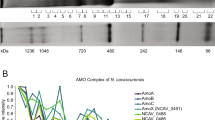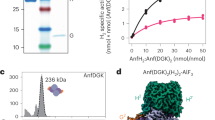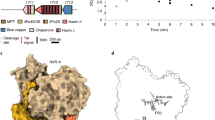Abstract
Anaerobic ammonium oxidation (anammox) has a major role in the Earth’s nitrogen cycle1,2 and is used in energy-efficient wastewater treatment3. This bacterial process combines nitrite and ammonium to form dinitrogen (N2) gas, and has been estimated to synthesize up to 50% of the dinitrogen gas emitted into our atmosphere from the oceans2. Strikingly, the anammox process relies on the highly unusual, extremely reactive intermediate hydrazine4, a compound also used as a rocket fuel because of its high reducing power. So far, the enzymatic mechanism by which hydrazine is synthesized is unknown. Here we report the 2.7 Å resolution crystal structure, as well as biophysical and spectroscopic studies, of a hydrazine synthase multiprotein complex isolated from the anammox organism Kuenenia stuttgartiensis. The structure shows an elongated dimer of heterotrimers, each of which has two unique c-type haem-containing active sites, as well as an interaction point for a redox partner. Furthermore, a system of tunnels connects these active sites. The crystal structure implies a two-step mechanism for hydrazine synthesis: a three-electron reduction of nitric oxide to hydroxylamine at the active site of the γ-subunit and its subsequent condensation with ammonia, yielding hydrazine in the active centre of the α-subunit. Our results provide the first, to our knowledge, detailed structural insight into the mechanism of biological hydrazine synthesis, which is of major significance for our understanding of the conversion of nitrogenous compounds in nature.
This is a preview of subscription content, access via your institution
Access options
Subscribe to this journal
Receive 51 print issues and online access
$199.00 per year
only $3.90 per issue
Buy this article
- Purchase on Springer Link
- Instant access to full article PDF
Prices may be subject to local taxes which are calculated during checkout



Similar content being viewed by others
References
Devol, A. H. Denitrification, anammox, and N2 production in marine sediments. Ann. Rev. Mar. Sci. 7, 403–423 (2015)
Lam, P. & Kuypers, M. M. M. Microbial nitrogen cycling processes in oxygen minimum zones. Ann. Rev. Mar. Sci. 3, 317–345 (2011)
Kartal, B., Kuenen, J. G. & van Loosdrecht, M. C. M. Sewage treatment with anammox. Science 328, 702–703 (2010)
Kartal, B. et al. Molecular mechanism of anaerobic ammonium oxidation. Nature 479, 127–130 (2011)
Strous, M. et al. Deciphering the evolution and metabolism of an anammox bacterium from a community genome. Nature 440, 790–794 (2006)
Kartal, B. et al. How to make a living from anaerobic ammonium oxidation. FEMS Microbiol. Rev. 37, 428–461 (2013)
Maalcke, W. J. et al. Structural basis of biological NO generation by octaheme oxidoreductases. J. Biol. Chem. 289, 1228–1242 (2014)
Putnam, C. D., Arvai, A. S., Bourne, Y. & Tainer, J. A. Active and inhibited human catalase structures: ligand and NADPH binding and catalytic mechanism. J. Mol. Biol. 296, 295–309 (2000)
Auld, D. S. Zinc coordination sphere in biochemical zinc sites. Biometals 14, 271–313 (2001)
Moser, C. C., Chobot, S., Page, C. & Dutton, L. Distance metrics for heme protein electron tunneling. Biochim. Biophys. Acta 1777, 1032–1037 (2008)
van de Vossenberg, J. et al. The metagenome of the marine anammox bacterium ‘Candidatus Scalindua profunda’ illustrates the versatility of this globally important nitrogen cycle bacterium. Environ. Microbiol. 15, 1275–1289 (2013)
Fülöp, V., Ridout, C. J., Greenwood, C. & Hajdu, J. Crystal structure of the di-heme cytochrome c peroxidase from Pseudomonas aeruginosa. Structure 3, 1225–1233 (1995)
Shimizu, H. et al. Crystal structure of Nitrosomonas europaea cytochrome c peroxidase and the structural basis for ligand switching in bacterial di-heme peroxidases. Biochemistry 40, 13483–13490 (2001)
Echalier, A. et al. Redox-linked structural changes associated with the formation of a catalytically competent form of the diheme cytochrome c peroxidase from Pseudomonas aeruginosa. Biochemistry 47, 1947–1956 (2008)
Jensen, L. M. R., Sanishvili, R., Davidson, V. L. & Wilmot, C. M. In crystallo posttranslational modification within a MauG/Pre-methylamine dehydrogenase complex. Science 327, 1392–1394 (2010)
Blaschko, H. The mechanism of catalase inhibitions. Biochem. J. 29, 2303–2312 (1935)
van der Star, W. R. L. et al. An intracellular pH gradient in the anammox bacterium Kuenenia stuttgartiensis as evaluated by 31P NMR. Appl. Microbiol. Biotechnol. 86, 311–317 (2010)
Bendtsen, J. D., Nielsen, H., von Heijne, G. & Brunak, S. Improved prediction of signal peptides: SignalP 3.0. J. Mol. Biol. 340, 783–795 (2004)
Brown, P. H. & Schuck, P. Macromolecular size-and-shape distributions by sedimentation velocity analytical ultracentrifugation. Biophys. J. 90, 4651–4661 (2006)
Kabsch, W. XDS. Acta Crystallogr. D 66, 125–132 (2010)
Vonrhein, C., Blanc, E., Roversi, P. & Bricogne, G. Automated structure solution with autoSHARP. Methods Mol. Biol. 364, 215–230 (2007)
Schneider, T. R. & Sheldrick, G. M. Substructure solution with SHELXD. Acta Crystallogr. D 58, 1772–1779 (2002)
Abrahams, J. P. & Leslie, A. G. W. Methods used in the structure determination of bovine mitochondrial F1 ATPase. Acta Crystallogr. D 52, 30–42 (1996)
Emsley, P. & Cowtan, K. Coot: model-building tools for molecular graphics. Acta Crystallogr. D 60, 2126–2132 (2004)
Cowtan, K. D. & Zhang, K. Y. J. Density modification for macromolecular phase improvement. Prog. Biophys. Mol. Biol. 72, 245–270 (1999)
Adams, P. D. et al. PHENIX: a comprehensive Python-based system for macromolecular structure solution. Acta Crystallogr. D 66, 213–221 (2010)
Murshudov, G. N., Vagin, A. A. & Dodson, E. J. Refinement of macromolecular structures by the maximum-likelihood method. Acta Crystallogr. D 53, 240–255 (1997)
Collaborative Computational Project, 4. The CCP4 suite: programs for protein crystallography. Acta Crystallogr. D 50, 760–763 (1994)
Petřek, M., Kosinova, P., Koca, J. & Otyepka, M. MOLE: a Voronoi diagram-based explorer of molecular channels, pores, and tunnels. Structure 15, 1357–1363 (2007)
Svergun, D. I. Determination of the regularization parameter in indirect-transform methods using perceptual criteria. J. Appl. Cryst. 25, 495–503 (1992)
Svergun, D. I., Petoukhov, M. V. & Koch, M. H. J. Determination of domain structure of proteins from X-ray solution scattering. Biophys. J. 80, 2946–2953 (2001)
Pettersen, E. F. et al. UCSF Chimera—a visualization system for exploratory research and analysis. J. Comput. Chem. 25, 1605–1612 (2004)
Acknowledgements
We dedicate this work to Simon de Vries, who passed away unexpectedly shortly before the publication of this paper. The Dortmund-Heidelberg data collection team and the staff of beamline X10SA at the Swiss Light Source of the PSI in Villigen, Switzerland are acknowledged for their help and facilities. M. Gradl and M. Müller are thanked for assistance with MALDI– and ESI–TOF mass spectrometric analyses. We thank I. Schlichting, J. Reimann, M. Cryle, J. Reinstein and R. Shoeman for suggestions and C. Kieser (electronics workshop at MPImF) for constructing the Peltier cooling controller used in post-crystallization treatment. T.R.M.B. thanks I. Schlichting for continuous support. B.K and W.J.M. were supported by the Netherlands Organization for Scientific Research (VENI grant 863.11.003 and Darwin grant 142.16.1201, respectively). C.F and M.S.M.J. are supported by the European Research Council (ERC232937) and by a Spinoza Prize awarded to M.S.M.J. Chimera is developed by the Resource for Biocomputing, Visualization, and Informatics at the University of California, San Francisco (supported by NIGMS P41-GM103311). This work was supported by the Max Planck Society.
Author information
Authors and Affiliations
Corresponding authors
Ethics declarations
Competing interests
The authors declare no competing financial interests.
Extended data figures and tables
Extended Data Figure 1 Small-angle X-ray Scattering (SAXS) results.
a, Semilogarithmic plot of scattered intensity I versus q, which was defined as q = (4π sin ϑ)/λ. The curve is an average over 200 measurements. Features are observed up to q = 0.4 Å−1. b, Guinier plot (plot of log I versus q2) showing that the protein is not aggregated. c, Kratky plot (plot of q2I versus q) showing that the protein is folded. d, Average of 18 (out of 20) dummy-atom reconstructions (beige) overlayed on the crystal structure (black).
Extended Data Figure 2 HZS-α sequences.
The HZS-α sequences from Kuenenia stuttgartiensis (kuste2861, gi 91200564), Jettenia caeni (Planctomycete KSU-1, ksu1d0439, tr A9ZRZ5), Brocadia sinica JPN1 (brosiA2676, gi 762182098) and Scalindua brodae (scabro01598, gi 726045835, re-confirmed by Sanger sequencing) were aligned in ClustalW and secondary structure elements were manually assigned based on the structure of Kuenenia HZS-α. Kuste2861 shares 81% sequence identity with its Jettenia and Brocadia orthologues and 61% with Scalindua. Fully conserved peptide sequences are marked black. The predicted signal peptides are highlighted in grey. The following residues are marked (numbering according to kuste2861): Cys303 coordinating Zn2+ (blue triangle), Tyr591 coordinating haem αI (pink asterisk), distal His772 of haem αII (green circle). The c-type haem binding motifs are highlighted in red. The figure was prepared using ESPript.
Extended Data Figure 3 Sequence alignments of HZS-β and HZS-γ.
The HZS-βγ fusion protein from Scalindua brodae (scabro01046, gi 726046454, re-confirmed by Sanger sequencing) was aligned using ClustalW to the fused sequences of K. stuttgartiensis HZS-β (kuste2859, gi 91200562) and HZS-γ (kuste2860, gi 91200563, lacking its predicted signal peptide) as well as to the fused sequences of Jettenia caeni (Planctomycete KSU-1) HZS-β (ksu1d0441, tr I3IPV5) and HZS-γ (ksu1d0440, tr A9ZRZ4, lacking its predicted signal peptide) and the fused sequences of Brocadia sinica JPN1 HZS-β (brosiA2674, gi 762182096) and HZS-γ (brosiA2675, gi 762182097, lacking its predicted signal peptide). Secondary structure elements were manually assigned based on the structures of K. stuttgartiensis HZS-β and HZS-γ. The first residue of HZS-γ in the HZS βγ fusions is indicated by a pink asterisk (starting at residue number 40 of K. stuttgartiensis HZS-γ, the numbers under the Scalindua sequence indicate the numbering in kuste2860). The Kuste2859–60 fusion shares 83% sequence identity with its J. caeni and B. sinica orthologues and 72% with S. brodae. Fully conserved peptide sequences are marked in black. The predicted signal peptides of the β-subunits are highlighted in grey. The following residues are marked (numbering according to kuste2859 and kuste2860): Glu253 in HZS-β (pink triangle), Cys165 covalently bound to haem γI, Asp168 near the haem γI catalytic site (blue triangle) and the distal His332 of haem γII (green circle). The c-type haem binding motifs are highlighted in red. The figure was prepared using ESPript. The predicted signal peptides of the γ-subunits not included in the alignment are: kuste2860: MAREMRLGGKERMKTGVVKIGLVAALGVVGLISAGGVYA―GQP…; ksu1d0440: MRNGMIKIGLVAALGIAGVVTAGEIMA―GTP… ;brosiA2675: MKSSLKIGLIAALGIAGVMTTGELMA―GTP.
Extended Data Figure 4 Details of HZS structure.
a, Covalent attachment of haem γI via three cysteine sulfur atoms. The simulated annealing 2mFo−DFc composite omit map is shown contoured at 1σ, overlaid on the final, refined structure. γCys102 and γCys105 are part of the canonical CXXCH motif (grey cartoon). In addition, there is a covalent bond between the Sγ atom of γCys165 and the C1 porphyrin methyl group of haem γI. b, Overlay of HZS γ (grey) with N. europaea CCP (PDB entry 1IQC, light brown) and P. denitrificans MauG (PDB entry 3L4M, dark brown). The positions of haems γI and γII correspond to those of the haems in CCP and MauG (sticks), as does the position of a calcium ion (spheres). The conserved tryptophan residue proposed to be involved in redox catalysis in MauG and CCP corresponds to His144 in HZS-γ (sticks). c, Xenon binding shows that haem αI is accessible from the solvent. The Xe atom is shown as a sphere. Green mesh: mFo−DFc map calculated before inclusion of Xe in the model, (10σ). αMet556 has assumed a new conformation.
Extended Data Figure 5 Electrostatic surface properties of the HZS complex.
Haem moieties are shown as sticks. a, Overview of the whole HZS structure. The bis-His-coordinated haem γII is indicated with a black circle. Haem αII is obscured in this view but its position is indicated by a black arrow. b, Magnified view of the electrostatic properties of the surface surrounding haem γII. A prominent negatively charged patch surrounds the haem as in cytochrome c binding sites. c, Magnified view of the vacuum electrostatic properties of the surface surrounding haem αII. No significant differences with the rest of the protein surface are observed. Figure prepared using UCSF Chimera32.
Extended Data Figure 6 EPR spectroscopy of HZS.
a, EPR spectra of HZS as isolated (black traces) and after addition of 200 µM NH2OH (blue traces) or 200 µM NO plus 200 µM NH4+ (red traces). The left panel shows the low magnetic field region highlighting the high-spin haem gx and gy resonances. The right panel shows the complete magnetic field scan where the intensity of the high-spin haem signals has run off-scale. Arrows indicate the positions of the various species that are listed in Extended Data Fig. 6c. The signal at 1540 Gauss is due to a small amount (<0.2% per αβγ unit) of adventitious iron. b, Simulation of the EPR spectra of HZS as isolated using the g values listed in Extended Data Fig. 6c . The difference between the simulation of HSp1 and the experimental spectrum defines the signal of HSp2 and its g value and suggests an amount of 0.41 per αβγ unit (see panel c). c, HZS haem content per αβγ unit determined by EPR. The total haem content determined by EPR was 0.92 ± 0.15 of the optically determined amount. nd, not detectable; LS, low-spin; HALS, highly anisotropic low-spin; HSp, rhombic high-spin peak. d, Stereofigure of the coordination of haem γII by γHis229 and γHis332. The perpendicular orientation of the histidine imidazole rings, both oriented towards haem meso atoms, is consistent with the g-values for HALS2. e, Stereofigure of the coordination of haem αII by αHis689 and αHis772. The orientation of the histidine imidazole groups, one (αHis772) oriented towards a haem nitrogen atom and the other (αHis689) towards a haem meso atom is consistent with the g values for HALS1 (see Supplementary Information).
Supplementary information
Supplementary Information
This file contains Supplementary Text and additional references. (PDF 154 kb)
Rights and permissions
About this article
Cite this article
Dietl, A., Ferousi, C., Maalcke, W. et al. The inner workings of the hydrazine synthase multiprotein complex. Nature 527, 394–397 (2015). https://doi.org/10.1038/nature15517
Received:
Accepted:
Published:
Issue Date:
DOI: https://doi.org/10.1038/nature15517
This article is cited by
-
Denitrification mechanism in oxygen-rich aquatic environments through long-distance electron transfer
npj Clean Water (2022)
-
Nitrogen isotope effects can be used to diagnose N transformations in wastewater anammox systems
Scientific Reports (2021)
-
Different nutrient levels, rather than seasonal changes, significantly affected the spatiotemporal dynamic changes of ammonia-oxidizing microorganisms in Lake Taihu
World Journal of Microbiology and Biotechnology (2021)
-
Comparative genomics in “Candidatus Kuenenia stuttgartiensis” reveal high genomic plasticity in the overall genome structure, CRISPR loci and surface proteins
BMC Genomics (2020)
-
Synthesis of silver nanoparticles using marine macroalgae Padina sp. and its antibacterial activity towards pathogenic bacteria
Beni-Suef University Journal of Basic and Applied Sciences (2020)
Comments
By submitting a comment you agree to abide by our Terms and Community Guidelines. If you find something abusive or that does not comply with our terms or guidelines please flag it as inappropriate.



